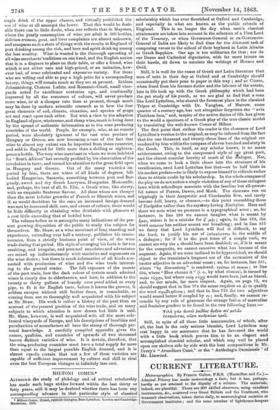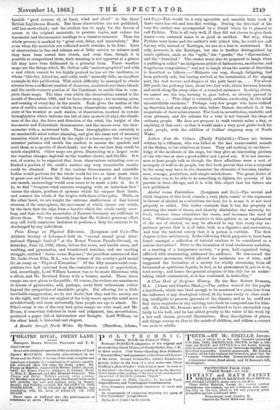CURRENT LITERATURE.
Meteorographica. By Francis Galton, F.R.S. (Macmillan and Co.)— Admiral Fitzroy has made meteorology a fact; but it has, perhaps, hardly as yet attained to the dignity of a science. The materials, indeed, are plentiful. There are 300 skilled observers, using excellent instruments, dzc., scattered over Great Britain and the Continent, who transmit observations, taken thrice daily, to meteorological societies or Government institutes ; and the same number of lighthouse-keepers
furnish "good returns of, at least, wind and cloud" to the three British Lighthouse Boards. But these observations are not published, still less methodized ; and the student has to apply for the favour of access to the original materials, to procure copies, and reduce the barometer and thermometer readings to a common measure. Thus the whole process is marked by " great cost, delay, and uncertainty." But even when the materials are collected much remains to be done. Lists of observations in line and column are of little service to science until they have been sorted into charts, and even then, though it is possible to comprehend them, their meaning is not apparent at a glance till they have- been delineated in a pictorial form. These weather maps are the things which Mr. Galion calls "meteorographica" and with a zeal which cannot be too highly praised he has set the institutes, to whom "this dry, laborious, and costly work" naturally falls, an excellent example in this publication. With much difficulty he managed to obtain returns from a sufficient number of observers, scattered over these islands and the north-western portion of the Continent, to enable him to com- plete these maps. The time over which the observations extend is the month of December, 1861, and we have three maps—for morning, noon, and evening of every day in the month. Each gives the outline of the area of earth's surface over which these observations extend, with the state of the weather at each station of observation, marked in certain hieroglyphics which indicate the fall of rain or snow (if any), the cloudi- ness of the sky, the force and direction of the wind, the height of the barometer and Fahrenheit thermometer, and the excess over the ther- mometer with a moistened bulb. These hieroglyphics are certainly to an unscientific mind rather alarming, and give the same sort of uncanny sensation which is produced by the sight of a horoscope; but a very few minutes' patience will enable the student to master the symbols and read them as a species of short-hand ; nor do we see how they could be much simplified. Other maps are given, illustrating on a larger scale the weather changes depicted on the weather charts, and the like. It is not, of course, to be expected that from observations extending over so limited a portion of the earth's surface any very remarkable results could be obtained. But if the various Governments and scientific bodies would perform for the whole world for two or three years what at great cost and labour Mr. Gabon has done for a part of Europe for one month, meteorology would soon cease to be made a joke of. As it is, we find "frequent wind currents sweeping with an unbroken flow" across the charts, portions of systems which far surpass their limits, and connect the winds of the tropics with those of the poles. While, on the-other hand, we are taught the extreme shallowness of that lowest stratum of the atmosphere, the movement of which causes our winds, by the facts that the Alps form a barrier which the winds rarely over- leap, and that even the mountains of Eastern Germany are sufficient to divert them. We very sincerely hope that Mr. Galton's generous effort may call forth numerous imitators to perform a duty too onerous to be discharged by any individual.































 Previous page
Previous page